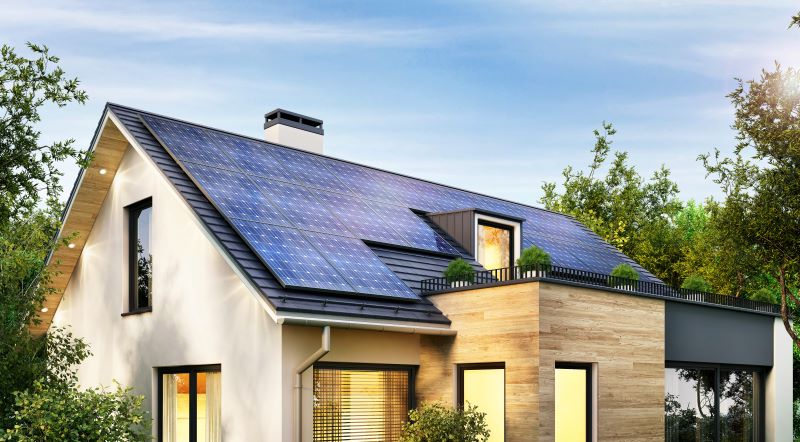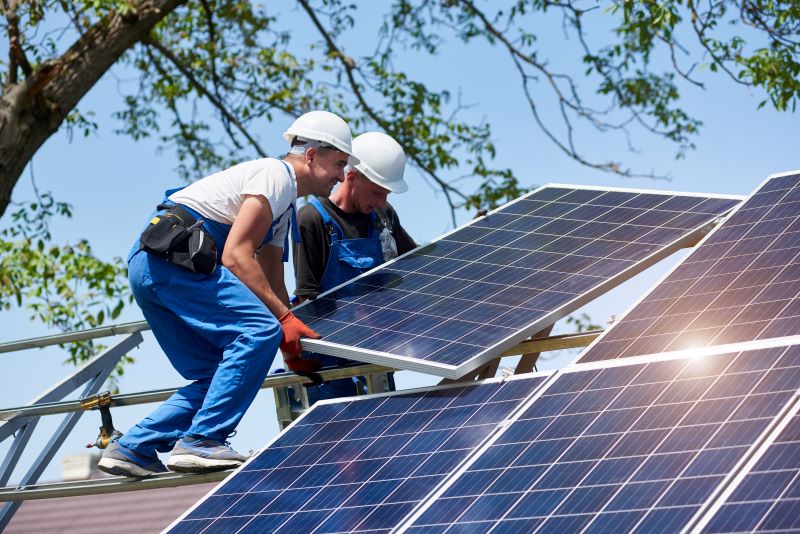Solar energy has become increasingly popular in residential properties due to its cost-effectiveness, environmental friendliness, and relative ease of installation. Notably, it’s generated using photovoltaic (PV) panels that convert solar radiation into electricity and can be used to power a variety of appliances and devices within a home.
In addition to providing clean electricity with minimal emissions or waste products, solar energy can also provide significant cost savings over time due to reduced utility bills.
This article will explore the benefits, costs, installation process, and maintenance of solar energy for residential properties.
Importance Of Solar Energy For Residential Properties
Solar energy is the most accessible and cleanest form of renewable energy available, making it a perfect power source for households. Solar energy allows homeowners to reduce their dependence on traditional electricity sources while helping to reduce greenhouse gas emissions and environmental pollution.
Solar power eliminates the need to purchase fuel or pay hefty utility bills as it can be used directly by families in their homes. Hence, it would be best to engage the services of reputable solar companies in your location, such as Smart Solar Energy in Beaverton Oregon, to start reaping the benefits of this technology.

Benefits Of Solar Energy For Residential Properties
The use of solar energy for residential properties provides a range of potential benefits, including the following:
-
Reduced Electricity Bills
By installing solar panels on their roofs, homes can generate electrical power, which can be used for most household activities and appliances. When the generated power exceeds what is needed, excess electricity can be sold back to the grid for a profit. The long-term savings from this process are substantial, as homeowners will no longer have to pay expensive utility bills month after month.
In addition to reduced electricity costs, solar energy offers an endless supply of free fuel that doesn’t damage the environment or contribute to global warming. Solar-powered home systems produce no emissions and require less maintenance or upkeep once installed.
-
Environmental Benefits
Harnessing solar power for residential dwellings can result in various environmental advantages. Solar energy is renewable and can be used without releasing greenhouse gases or other pollutants into the atmosphere, making it a sustainable choice. It also eliminates the need to rely on burning fossil fuels, which are limited resources that emit large amounts of carbon dioxide into the atmosphere and contribute to global warming.
Installing PV panels on homes means less reliance on nonrenewable fossil fuel-generated electricity from utility companies, reducing their emissions further. Ultimately, transitioning to solar power offers numerous environmental benefits that protect the planet and ensure future generations have access to clean air and unpolluted environments to thrive.
-
Increased Property Value
Installing solar power systems can increase the property’s value, making it a viable long-term investment. Here are several ways that installing solar power systems can increase a home’s market value:
- Solar panels tend to be seen as a modern amenity by potential buyers, so adding them can attract more prospective buyers.
- Solar energy systems save homeowners money on repair bills and reduce future expenses for potential buyers.
- Homeowners who install these systems often qualify for government incentives that provide tax credits and further contribute to increasing the property’s overall worth.
- Installing solar panels is an eco-friendly decision, as it’s increasingly important for many people when looking for a place to live.
Ultimately, investing in a solar energy system leads to increased property values directly from implementing such technology and indirectly from reduced utility bills or other associated incentives.
-
Incentives And Tax Credits
Incentives and tax credits can significantly reduce the initial expenses associated with investing in solar power for residential properties. State and federal governments are increasingly offering incentives as part of their commitment to renewable energy sources, such as solar power.
The federal investment tax credit (ITC) is one of the most widespread solar energy system incentives for homeowners. The ITC offers taxpayers a credit of 30% of their qualifying costs, including labor and equipment costs associated with installing solar panels. Some states also provide additional incentives that make it even more attractive for homeowners to invest in renewable energy sources like solar power.
Costs Of Solar Energy For Residential Properties
The cost of solar energy for residential properties can be broken down into two primary categories, such as the following:
-
Initial Installation Costs
Investing in renewable energy sources can be expensive initially, but long-term savings are worth it. The initial installation costs are usually the most expensive part of the process for homeowners looking to switch to solar energy for their residential property.
This cost can vary depending on the size, location, and type of system you choose. Installing a solar system typically involves purchasing or leasing PV panels and other equipment needed for conversion into usable electricity. Some states may also require additional permits and fees, which could add to the overall cost.
-
Maintenance Costs
Switching from traditional energy sources to renewable sources can bring numerous advantages, but it’s vital to consider the maintenance costs involved. Maintenance costs for a residential solar system typically depend on several factors, such as the size of the system and its location.
Generally, smaller systems require less maintenance than larger ones since they are easier to access for servicing. Solar installations in harsh climates may also require more frequent maintenance since dust and debris can accumulate on their panels, reducing efficiency.
Installation Process of Solar Panels
The installation process of solar panels is a complex and multi-step process, with site assessment, design and planning, permitting, installation, and interconnection, with the utility grid being key steps. Here’s an in-depth discussion regarding each step:
-
Site Assessment
Conducting a site assessment is crucial for those considering investing in an alternative energy solution. This is because the assessment results will determine if solar energy is suitable for the home and whether or not it can provide enough power to meet the homeowner’s needs. Site assessments are done by qualified technicians who can evaluate the area, given factors such as climate and weather conditions, available space, and local regulations.
-
Design And Planning
This stage involves creating the most efficient system layout and determining what components will be needed for installation. The following criteria should be considered when designing and planning a solar energy system:
- Location: The solar system’s location must consider surrounding buildings, trees, terrain, and other factors that could affect performance.
- Orientation: Solar panels should face south or southwest to maximize sunlight exposure throughout the day.
- Panels: Choose panels that balance power output efficiency and cost-effectiveness.
- Inverter: Select an inverter that meets your needs while providing maximum efficiency at minimum cost.
- Wiring And Mounts: Ensure all wiring is rated correctly and all mounts are securely installed to ensure the safe operation of your system.
By knowing these factors, you can now seamlessly install your solar panels on your residential property.
-
Obtain Necessary Permits
It’s necessary to obtain the appropriate permits to move forward with a solar energy system installation for residential properties. This process can vary from jurisdiction to jurisdiction and will require research from the homeowner or installer.
Generally, permits are required when installing any large piece of equipment that affects a home’s structure or electrical wiring. Before installing, it is important to check local laws and regulations and contact relevant government agencies.
-
Installation
Installing a solar energy system for residential properties requires knowledge of local laws and regulations and hiring a qualified professional to ensure all requirements are met. Some important considerations when installing a solar energy system include:
- Making sure the roof is in good condition and strong enough to support the weight of the solar panels.
- Selecting quality components that meet efficiency standards.
- Ensuring compliance with local codes.
Installing a solar energy system can be an intimidating process, but with the help of experts in this field, it can be a gratifying experience.
-
Interconnection With The Utility Grid
Solar power systems can reliably provide renewable energy for residential properties by interconnecting with the utility grid. This is done by connecting the PV system to the grid, which allows electricity produced by the PV system to be used in the home and sent back into the grid when there is an excess supply. Interconnection also allows homes with PV systems to draw power from the utility grid when their solar panel output is insufficient.
Interconnection with a utility grid offers many advantages, such as providing backup power in case of emergencies or other outages, allowing homeowners to leverage net metering policies and receive credit for any excess electricity generated by their PV system that flows back into the grid, and avoiding having to purchase expensive battery storage units or generators.
Maintenance Of Solar Panels On Residential Properties
Maintenance is an essential step in keeping your solar panels working for a long time. Here are some maintenance tips you can follow:
-
Cleaning And Inspection
Regularly examining and addressing any issues is essential to ensuring the system’s optimal performance. Cleaning and inspection of solar panels on residential properties should be done at least twice a year, as dirt, dust, leaves, or other debris can affect the efficiency of the solar panel. Moreover, inspecting for any physical damage, such as cracks or broken glass, must be done to ensure proper functioning.
Cleaning helps remove dirt build-up, which can interfere with solar cells’ efficient absorption of sunlight. Likewise, regular inspections can help identify potential issues before they become serious problems requiring costly repairs or replacements.
-
Inverter Maintenance
Inverter maintenance is essential for ensuring the optimal functioning of a solar energy system. The inverter is the component of a solar energy system that takes the direct current (DC) electricity produced by the solar panels and converts it into alternating current (AC) electricity, which can be used by appliances and other electrical devices in residential properties.
Proper inverter maintenance requires checking to ensure there are no loose connections, testing if it’s producing the correct output voltage, checking for any signs of physical damage or corrosion, and replacing any parts that may have worn out. Additionally, regular software updates should also be installed when available to ensure optimal performance.
-
Battery Maintenance
Battery maintenance is integral to keeping a solar energy system functioning efficiently and reliably, offering peace of mind to those who have invested in this technology. It’s important to keep batteries clean so that they function at their best.
Additionally, regular testing should be conducted to check for any issues with the voltage or amperage levels. Keeping up with battery maintenance will help extend the life of the batteries and minimize long-term costs associated with repair or replacement.
-
Warranty And Repair
A vital factor to consider when investing in a solar energy system is the warranty and repair services offered by the manufacturer. These services can help ensure your system remains in optimal condition for many years, protecting you from costly repairs or replacements.
When researching these services, be sure to inquire about any warranties on parts or labor and what type of customer service they provide. In addition to warranty and repair coverage, it’s wise to inquire about preventative maintenance options for your system.
Conclusion
Solar energy is an increasingly popular and viable option for providing clean, renewable power to residential properties. This has been made possible by recent technological advances, which have reduced the cost of solar panels and their installation.
Although there are costs associated with installing and maintaining a residential solar panel system, many of these can be offset by government subsidies or tax credits. Overall, investing in solar power is a sound choice for those who wish to take advantage of this renewable energy source while reducing their environmental impact.

